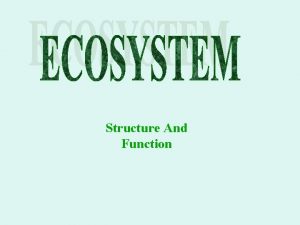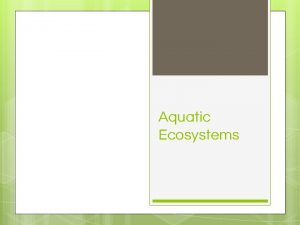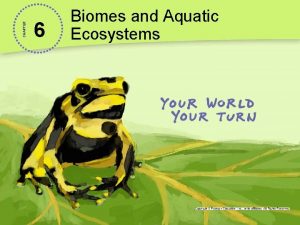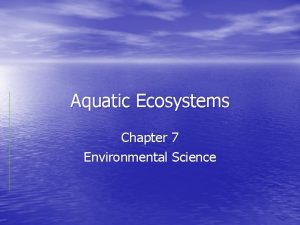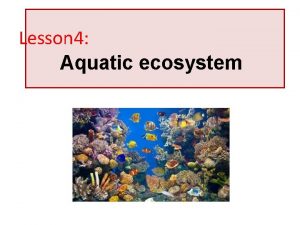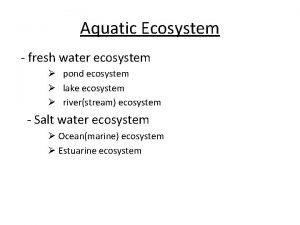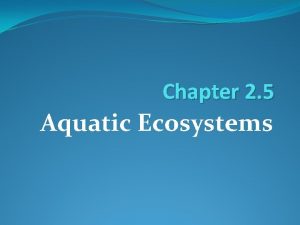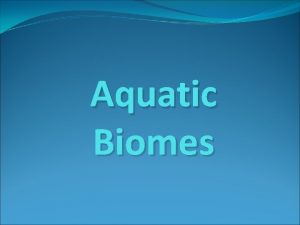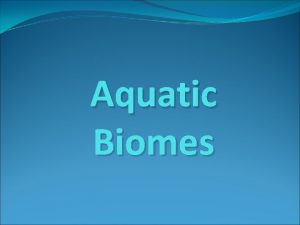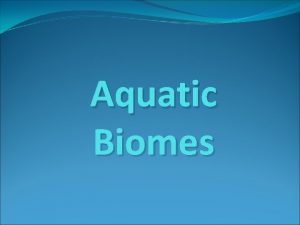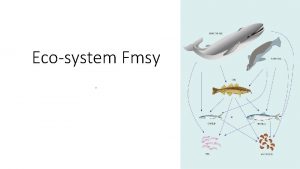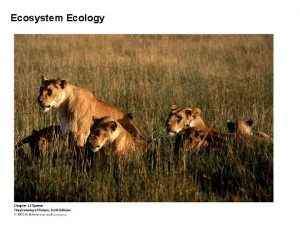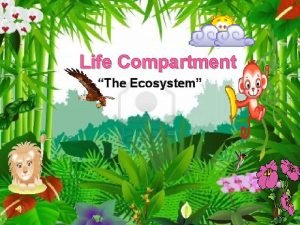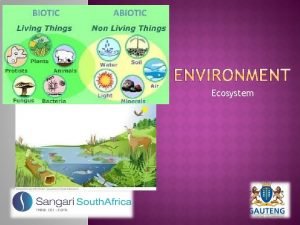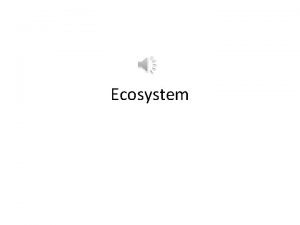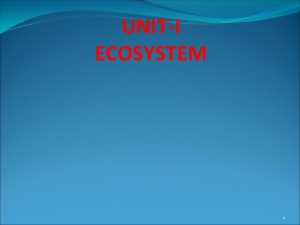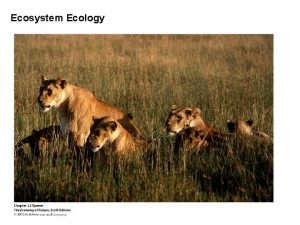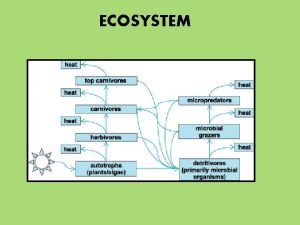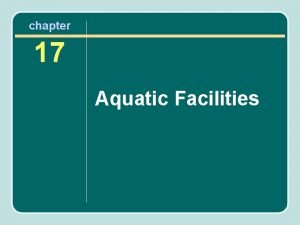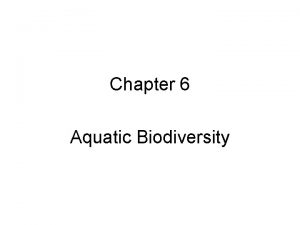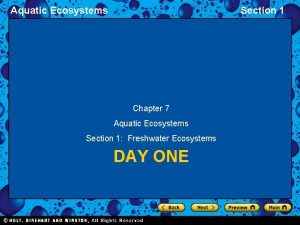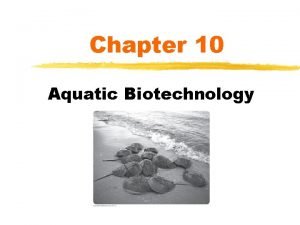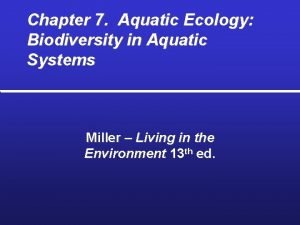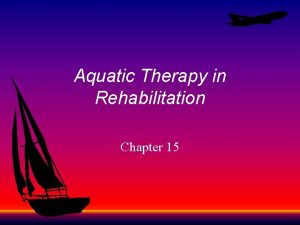Chapter 3 The Aquatic Environment Aquatic ecosystem 75

















































- Slides: 49

Chapter 3 The Aquatic Environment

• Aquatic ecosystem: 75% of planet surface • The major feature influencing the adaption of organism: salinity saltwater (marine) freshwater

3. 1 Water cycles between earth and the atmosphere • Water cycle:hydrologic cycle • water→ water vapor→ precipitation ↑ solar energy (evaporation) ↓ driving force

Fig. 3 -1

• Interception(攔截): water is intercepted by vegetation, dead organic matter or urban structure and streets → water never infiltrate the ground, but evaporate directly back to the atmosphere. Infiltration(滲透): water reach the soil move into the ground →Infiltration rate: type of soil, slope, vegetation and intensity of the precipitation.

• Surface runoff: overland flow groundwater • Transpiration: the evaporation of water from internal surface of leaves, stem, and other living part • Evapotranspiration:the total flux of evaporating water → evaporation+ transpiration

Fig. 3 -2 2% 0. 3% 97%

3. 2 Water has important physical properties

Fig. 3 -3

The structure of water is based on hydrogen bonds • Covalent bond(共價鍵)→ hydrogen bond: easily broken and reformed • Polar covalent bond

• High Specific heat: the number of calories necessary raise 1 g of water 1℃ →warm up slowly in spring and cool off just as slowly in the fall: prevent the wide seasonal fluctuation in the temperature of the aquatic habitats → thermal regulation of organism: temperature variation is moderated relative to change in ambient temperature

• High Specific heat: the number of calories necessary raise 1 g of water 1℃ Gas→ liquid→ solid ↓ ↓ evaporation ↓ ↓ latent heat: 536 cal 80 cal

Fig. 3 -4

• Surface tension: cohesion(內聚力): hydrogen bond • Viscosity: the resistance of a liquid to flow → the frictional resistance of water is 100 times greater than air: due to high density (860 times) →reduce this frictional resistance→ streamline body • High density: Buoyancy: unnecessary structural material to erect against the force of gravity and movement • water pressure: increase 1 atm (1 kg/cm 2) per 10 m

Water strider

Sperm whale抹香鯨

3. 3 Light varies with depth in aquatic environments • The amount of light in the water reduced by two process (1) suspended particles (2) water itself absorbs light

Fig. 3 -7

3. 3 Light varies with depth in aquatic environments • The amount of light in the water reduced by two process (1) suspended particles (2) water itself absorbs light • (1) red and infrared radiation (2) yellow→ green→ violet →leaving only blue: 100 m→ 10% of blue light

• Adaptation: (1) silver gray and deep black (2) lack pigment (3) large eye: maximum light-gathering ability (4) organ: produce light (bioluminescence)

3. 4 Temperature varies with water depth

Fig. 3 -8

Vertical circulation: fall turnover→ nutrient dynamic Temperate Zone 4℃

Flowing water: water temperature follow air temperature

3. 5 Water functions as a solvent • Solution: 溶液 solvent: 溶劑 solute: 溶質 → aqueous solution • Water is excellent solvent: biological crucial substance (1) nutrient and waster can be dissolved and transported (2) regulate temperature (3) preserves chemical equilibrium

• The attraction between water and salt > ionic bond→ dissolve • ocean: still(蒸餾器) → the concentration of solute is limited by the maximum solubility of the compound→ deposited • psu: Practical Salinity Units

Fig. 3 -2


3. 6 Oxygen diffuse from the atmosphere to the surface water • Diffusion: molecule to move from high concentration to one of lower concentration • The diffusion process result in a net transfer of oxygen and carbon dioxide from the atmosphere into surface water and from surface to deep water.

• Diffusion rate: (1) the solubility of oxygen in water (2) the steepness of the diffusion gradient • DO→ temperature: temp↑ DO↓ pressure: P↑ DO↑ salinity: S↑DO↓ • High viscosity and density→ the diffusion was 10000 times slower than in water than in air →Oxygen absorbed by surface water is mixed with deeper water by turbulence and internal current • Oxygen maintain saturation in shallow or rapidly flowing water → the increase of absorptive surface at the air-water interface

Fig. 3 -11

Diffusion, wind and photosynthesis Temp↓ Do↑ Oxygen was replenished

The limited depth of vertical circulation

• The solubility of gases is not great atmosphere: 21% fresh water at 0℃: 1%

3. 7 Acidity has a widespread influence on aquatic environment • CO 2+H 2 O↔H 2 CO 3↔HCO 3 -1↔H++CO 3 -2 ↓ ↓ carbonic acid bicarbonate ion →a buffer to keep the p. H within a narrow range • Acidity: � H� Alkaline: � OH� • p. H=- log � H� p. H=6 → � H� =10 -6 , � OH� =10 -8

Fig. 3 -14

• Natural water: p. H: 2 -12 • Sea water: 7. 5 -8. 4 • acidity→ influence on the distribution and abundance of organism high acidity→ physiological (direct) or the concentration of toxic heavy metal (indirect) → tolerance limit: 4. 5: low p. H→high Al (highly toxic)

3. 8 Water movements shape freshwater and marine environments • Water movement: current in stream and wave in open body of water • Fast stream: velocity > 50 cm/sec → remove all particle less than 5 mm • Wave: wind→ ripple→ wave →more energy (wind continue blow) → wave continue to grow→ wind energy= energy lost by breaking wave (white cape) →wave approach land: the height of each wave rises until wave front grow to steeps and topples over • Thermohaline circulation • Upwelling

Fig. 3 -15 Silt and decaying organic matter accumulate on the bottom

Fig. 3 -16



3. 9 Tides dominate the marine environment • tide:the gravitational pull of the sun and moon • moon:two lunar tidal bulges (high tide) every day (12 hour 25 min) ,two of the lows or low tides • Sun: new and full→ brimming fullness → neap tides



• Tide advance: westward • Intertidal zone: dramatic shift in environmental condition

3. 10 The transition zone between freshwater and saltwater environments present unique constraints • Estuary: freshwater join and mix with the salt water (1) homogenous→ current strong enough to mix the water from top to bottom. (2) stratification→ surface: fresh bottom: salty water (2) low tide: homogenous high tide: surface wedge of seawater move upstream more rapidly than the bottom seawater → density is inverted: tidal overmixing


• Horizon • Salinity: left>right
 Deseart animals
Deseart animals Pyramid of biomass in aquatic ecosystem
Pyramid of biomass in aquatic ecosystem Ecological pyramid
Ecological pyramid Describe aquatic ecosystem
Describe aquatic ecosystem The uppermost layer of an aquatic ecosystem
The uppermost layer of an aquatic ecosystem Financial environment in business environment
Financial environment in business environment Transitional aquatic ecosystems
Transitional aquatic ecosystems Epiphytes plants
Epiphytes plants Why biomes are important
Why biomes are important Chapter 3 lesson 3 biomes and aquatic ecosystems
Chapter 3 lesson 3 biomes and aquatic ecosystems Limestone ridges built by tiny animals
Limestone ridges built by tiny animals Chapter 7 aquatic ecosystems test answers
Chapter 7 aquatic ecosystems test answers Hình ảnh bộ gõ cơ thể búng tay
Hình ảnh bộ gõ cơ thể búng tay Ng-html
Ng-html Bổ thể
Bổ thể Tỉ lệ cơ thể trẻ em
Tỉ lệ cơ thể trẻ em Gấu đi như thế nào
Gấu đi như thế nào Tư thế worms-breton
Tư thế worms-breton Bài hát chúa yêu trần thế alleluia
Bài hát chúa yêu trần thế alleluia Các môn thể thao bắt đầu bằng tiếng đua
Các môn thể thao bắt đầu bằng tiếng đua Thế nào là hệ số cao nhất
Thế nào là hệ số cao nhất Các châu lục và đại dương trên thế giới
Các châu lục và đại dương trên thế giới Cong thức tính động năng
Cong thức tính động năng Trời xanh đây là của chúng ta thể thơ
Trời xanh đây là của chúng ta thể thơ Cách giải mật thư tọa độ
Cách giải mật thư tọa độ Làm thế nào để 102-1=99
Làm thế nào để 102-1=99 Phản ứng thế ankan
Phản ứng thế ankan Các châu lục và đại dương trên thế giới
Các châu lục và đại dương trên thế giới Thơ thất ngôn tứ tuyệt đường luật
Thơ thất ngôn tứ tuyệt đường luật Quá trình desamine hóa có thể tạo ra
Quá trình desamine hóa có thể tạo ra Một số thể thơ truyền thống
Một số thể thơ truyền thống Cái miệng bé xinh thế chỉ nói điều hay thôi
Cái miệng bé xinh thế chỉ nói điều hay thôi Vẽ hình chiếu vuông góc của vật thể sau
Vẽ hình chiếu vuông góc của vật thể sau Thế nào là sự mỏi cơ
Thế nào là sự mỏi cơ đặc điểm cơ thể của người tối cổ
đặc điểm cơ thể của người tối cổ Ví dụ giọng cùng tên
Ví dụ giọng cùng tên Vẽ hình chiếu đứng bằng cạnh của vật thể
Vẽ hình chiếu đứng bằng cạnh của vật thể Vẽ hình chiếu vuông góc của vật thể sau
Vẽ hình chiếu vuông góc của vật thể sau Thẻ vin
Thẻ vin đại từ thay thế
đại từ thay thế điện thế nghỉ
điện thế nghỉ Tư thế ngồi viết
Tư thế ngồi viết Diễn thế sinh thái là
Diễn thế sinh thái là Dot
Dot Số.nguyên tố
Số.nguyên tố Tư thế ngồi viết
Tư thế ngồi viết Lời thề hippocrates
Lời thề hippocrates Thiếu nhi thế giới liên hoan
Thiếu nhi thế giới liên hoan ưu thế lai là gì
ưu thế lai là gì Sự nuôi và dạy con của hươu
Sự nuôi và dạy con của hươu
